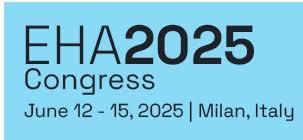
We're bringing you daily updates from the CML sessions at EHA2025 Congress. Check back each day for updates on the day's sessions.
Stay tuned for more coverage of CML @ EHA2025 over the next few days!
Day 2:
Session: Oral Session: Chronic myeloid leukemia - Clinical
Chairs:
Susanne Saussele (Germany)
Franck Emmanuel Nicolini (France)
Presentation 1: ENABLE: A phase 1A/1B study of ELVN-001, a selective active site inhibitor of BCR::ABL1, in patients with previously treated CML (S165)
Speaker: Andreas Hochhaus, University of Jena, Germany
“ELVN-001 is a novel active site inhibitor of BCR::ABL1 that showed a favourable safety and tolerability profile in this phase 1 study. It also showed encouraging anti-CML activity in a heavily pretreated population.” (Andreas Hochhaus)
Key Points:
- Unmet needs in CML: ELVN-001 addresses off-target toxicities, drug interactions, and resistance mechanisms common with ATP-competitive TKIs.
- Mechanism of action: Targets the P-Loop in the inactive ATP-binding conformation, with activity against key mutations (e.g., T315I).
- Safety profile: No maximum tolerated dose and no dose-toxicity relationship identified; adverse events (AEs) were generally low-grade and manageable with low rates of dose reductions and discontinuation due to AEs.
- Efficacy in late-stage CML: 47% molecular response rate by 24 weeks, including 32% achieving MMR; 100% maintained prior MMR status; efficacy observed in patients exposed to prior asciminib or ponatinib.
- Pharmacokinetics: ELVN-001 pharmacokinetic profile supports once-daily dosing with or without food, which, in addition to low potential for drug-drug interactions, addresses key challenges with currently available TKIs.
Presentation 2: Asciminib shows superior tolerability vs nilotinib in newly diagnosed CML in chronic-phase: Primary endpoint results of the phase 3B ASC4START trial (S166)
Speaker: Andreas Hochhaus, University of Jena, Germany
“The safety profile of asciminib remained consistent with earlier trials with no new safety signals. There was a 55% lower risk of discontinuation due to adverse events with asciminib compared to nilotinib.” (Andreas Hochhaus)
Key Points:
- Study design and rationale: Focused on time-to-discontinuation due to adverse events (TTDAE) as a primary endpoint, addressing regulatory requests for tolerability data.
- Primary study endpoint: The ASC4START trial met its primary endpoint and asciminib demonstrated significantly superior tolerability vs nilotinib.
- Safety and tolerability results: The safety profile of asciminib remained consistent with earlier trials; TTDAE was significantly lower with asciminib (HR 0.45); key toxicities (liver, pancreas, rash) more common in nilotinib arm.
- Efficacy (Early response): Week 12 molecular responses – including MMR and 1% BCR::ABL1 thresholds – were higher with asciminib.
- Implications for practice: These data, along with the data from ASC4First, further support asciminib’s potential as a first-line standard-of-care option for newly diagnosed CML, with long-term TFR still under study.
Presentation 3: CML treatment discontinuation after a two-step dose reduction. The first results of the phase 2 study HALF (S167)
Speaker: Jiří Mayer, Masaryk University, Brno, Czech Republic
“We hypothesised that gradual de-escalation could reduce the loss rate of TFR and withdrawal symptoms. Data is still to be considered preliminary, but double-step de-escalation may become a new approach for stopping TKI therapy in CML patients.” (Jiří Mayer)
Key Points:
- Study design & hypothesis: Two-step dose de-escalation (50% dose for 6 months, then every-other-day for 6 months) before stopping TKIs to improve TFR success and reduce withdrawal syndrome.
- Treatment-free remission (TFR) rates: High TFR rates achieved; significant BCR::ABL1 level increase during de-escalation predicted relapse.
- Withdrawal syndrome reduction: Frequency of withdrawal syndrome is low; reduced musculoskeletal symptoms and fewer new/worsening symptoms compared to abrupt cessation.
- Metabolic insights: Imatinib cessation linked to decreased adiponectin and increased cholesterol, suggesting metabolic effects persist post-therapy.
- Future implications: Double-step TKI de-escalation strategy shown to be feasible and safe; full results expected in one year. Potential to redefine standard stopping protocols.
Presentation 4: Comparison of molecular response and safety of lower dose (70 mg) versus standard dose (100 mg) of generic dasatinib in newly diagnosed patient with CML-CP: Randomised controlled study from India
Speaker: Para Satadeve, Rajiv Gandhi Cancer Institute and Research Centre, Delhi, India
“Lower dose generic dasatinib 70 mg per day is non-inferior to the standard dose with fewer adverse events and has high clinical value, especially in resource-limited settings.” (Para Satadeve)
Key Points:
- Patient population: 120 newly diagnosed CML-CP patients in India; younger median age (39 years); majority high disease burden.
- Molecular efficacy: Lower dose generic dasatinib (70 mg/day) is non-inferior to the standard dose (100 mg/day) in achieving key molecular milestones across all risk groups
- Safety & tolerability: Significantly fewer hematological and non-hematologic toxicities, better tolerability, and fewer dose interruptions and reduction observed with dasatinib 70 mg/day.
- Cost and access: Generic dasatinib (~$210 or $180/year) and lower dose strategy offers effective and affordable care for low- and middle-income countries.
- Future directions: Study results suggest dasatinib 70 mg as a potential new standard of care, especially in LMICs to improve access, adherence, and outcomes.
Presentation 5: Characterisation and efficacy of TERN-701 in pre-clinical models of CML
Speaker: Timothy Hughes, SAHMRI, Adelaide
“We do not see evidence of any other kinase inhibition - even at high doses. TERN-701 is incredibly selective. It covers most mutations of concern – including 315, 317, and 244 – with high potency.” (Timothy Hughes)
Key Points:
- Mechanism of action & mutation coverage: TERN-701 binds the myristoyl (STAMP) pocket with high specificity, retaining activity against most BCR::ABL mutations including 315, 317, 244, and some compound variants.
- Selectivity profile: Screened against 450 kinases; showed clean profile with minimal off-target inhibition- including no significant ABL inhibition.
- Clinical Pharmacokinetics: Phase I data show high serum levels (500 mg QD achieves ~1,000 ng/mL), sufficient to cover IC50 and IC90 for nearly all mutations except a few allosteric variants (e.g., 468, 465).
- Limitations: Not effective in BCR::ABL-independent resistance (e.g., transporter issues, overexpression); broader activity (e.g., of ponatinib) may be needed in such cases.
- Pre-clinical development: Phase 1, dose escalation/expansion CARDINAL trial to evaluate safety and efficacy of TERN-701 is ongoing; additional preclinical studies are underway to further characterise TERN-701.
Day 1:
Session: Specialized Working Group Session:
Chronic myeloid leukemia and its stem cells
Chair: Nick Cross (UK)
Presentation 1: Modelling stem cell dynamics in CML
Speaker: Rick Van Etten, University of California, Irvine
“Both HSLL compartment size and self-renewal capacity influence the response to TKI therapy”
(Rick van Etten)
Key Points:
- Primary resistance modelling: Developed mathematical and mouse models demonstrating that leukemic stem cell (LSC) expansion and high self-renewal contribute to primary TKI resistance.
- Role of TET2 mutations: Found that TET2 mutations enhance self-renewal and worsen TKI responses, even if not within the BCR::ABL+ clone.
- Threshold and latency effects: Identified a ~4–5% LSC chimerism threshold needed for disease progression, with latency and stochastic effects suggesting non-mutational mechanisms.
- Immune and stress mechanisms: Proposed that immune surveillance and oncogene-induced replicative stress are critical for maintaining remission in the presence of residual LSCs.
- Clinical implication of model findings: These data challenge the paradigm that BCR::ABL1 is sufficient for leukemogenesis, and are consistent with other recent findings of non-mutational mechanisms of cancer development.
Presentation 2: Insights from single-cell analysis of CML stem cells
Speaker: Göran Karlsson, University of Lund
“We can now separate stem cells at diagnosis into CD26+ leukemic stem cells and CD35+ normal hematopoietic stem cells.”
(Göran Karlsson)
Key Points:
- Stem cell classification: Using single cell RNA-seq and antibody barcoding to distinguish CD26+ leukemic stem cells from CD35+ residual healthy stem cells.
- TKI sensitivity markers: Identified quiescent, CD26+/CKIT– cells as resistant to TKIs; MegE-primed clones responded better to therapy.
- Residual stem cell function: CD35+ cells were the only subset to show strong stem cell enhancer activity and long-term repopulating ability in mice.
- Prognostic utility of profiling: CD26/CD35 profiling at diagnosis predicted response quality and TKI cessation success; lack of CD35+ cells linked to poor outcomes.
- Blast crisis prediction: High-resolution single-cell data revealed that progenitor-like transcriptional shifts at diagnosis could predict transformation risk.
Presentation 3: 2025 ELN recommendations on the management of CML
Speaker: Jane Apperley, Imperial College London
“We aim to help clinicians personalise treatment … deciding whether the aim for therapy is improved survival or an attempt at treatment free remission, taking into account prognostic factors at diagnosis and comorbidities in the choice of therapy and obviously considering the affordability and availability in your country”
(Jane Apperley)
Background:
The European LeukemiaNet (ELN) has issued expert consensus recommendations for managing CML since 2006, with updates in 2009, 2013, and 2020. The 2025 version, recently accepted for publication in Leukemia, reflects evolving clinical data, new therapies, and a growing emphasis on individualised care.
Key Points:
- Classification and phase definition: WHO disease classification has removed accelerated phase (AP); ELN retains AP due to lack of panel consensus on phase classification. This offers flexibility for treating physicians.
- Prognostic markers: ELTS score and baseline chromosomal abnormalities retained as key risk indicators; somatic mutations (e.g., ASXL1) considered investigational.
- Response milestone updates: New categories ‘favourable’, ‘warning’, and ‘unfavourable’- aim to reduce stigma and clarify implications for therapy changes.
- Late responders and treatment switching: Emphasises individualised decision-making, especially for older patients or those with trending molecular improvement.
- TFR eligibility and early response: Strong early responders (<1% BCR::ABL1 at 12 months) most likely to achieve successful treatment-free remission.
- Treatment guidance: Newer TKIs, asciminib and olverembatinib, show improved molecular metrics but not yet overall survival benefit; starting dosage of more potent TKIs should be individualised.










